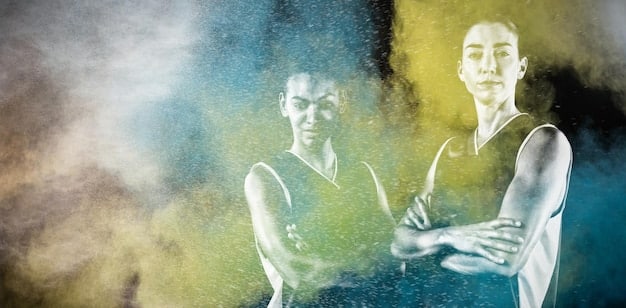New NCAA NIL Changes: Recruiting Shifts Expected in 6 Months

The latest NCAA rule adjustments concerning Name, Image, and Likeness (NIL) deals are poised to significantly reshape college sports recruiting strategies within the next six months, demanding immediate adaptation from athletic programs and prospective student-athletes.
The landscape of college sports is in constant flux, but few changes have ignited as much debate and anticipation as the evolution of Name, Image, and Likeness (NIL) deals. An Alert: New NCAA Rule Changes on NIL Deals Could Drastically Alter College Sports Recruiting in the Next 6 Months, signaling a pivotal moment for athletes, universities, and the very fabric of collegiate athletics.
Understanding the Shifting Sands of NIL
For decades, the concept of amateurism strictly governed college sports, prohibiting student-athletes from profiting from their name, image, and likeness. This long-held tradition was fundamentally challenged and ultimately dismantled. The initial loosening of NIL restrictions opened Pandora’s Box, leading to a new era where collegiate athletes could finally monetize their personal brand.
The initial implementation, though groundbreaking, was marked by ambiguity and a patchwork of state laws and institutional policies. This created an uneven playing field, where some states and schools offered more lucrative opportunities than others, leading to concerns about fair play and equitable access. These early days highlighted the urgent need for a more structured and consistent regulatory framework from the National Collegiate Athletic Association (NCAA).
The NCAA’s recent rule changes are a direct response to this evolving environment, aiming to provide more clarity and, theoretically, a more level playing field for recruiting. These adjustments are not minor tweaks but substantial revisions designed to close loopholes, establish clearer guidelines, and address what many perceived as a chaotic free-for-all. The core intent behind this new wave of regulations appears to be an effort to bring some order to the NIL landscape while still preserving the ability for athletes to engage in these valuable opportunities.
The Road to Reform: Why Changes Were Necessary
The journey from the initial NIL rollout to these latest rule modifications has been complex, driven by various factors. The sheer scale and speed at which NIL deals proliferated caught many off guard, leading to unforeseen consequences and challenges. Athletes and institutions alike struggled with the novelty of the situation, often operating in a gray area.
- Lack of Uniformity: Differing state laws and university policies created a disjointed system, making it difficult for the NCAA to enforce consistent standards.
- Recruiting Inducements: Concerns arose that NIL deals were being used as direct inducements for recruitment, blurring the lines between legitimate endorsement opportunities and pay-for-play schemes.
- Transparency Issues: The private nature of many NIL agreements made it challenging to track deal sizes, beneficiaries, and compliance, leading to suspicions of impropriety.
These issues, among others, created a volatile environment that threatened the integrity of collegiate athletics. The new rules thus seek to address these pain points head-on. The NCAA’s revised approach is an attempt to strike a delicate balance: allowing athletes to benefit financially while maintaining a semblance of control over the recruiting process and ensuring competitive equity. The urgency of these changes is underscored by the rapid pace of the college sports calendar, where recruiting never truly stops.
As these new guidelines are digested and implemented, their full impact on recruitment will become apparent. Universities, coaches, and prospective athletes must now navigate a system that is both more regulated and potentially more complex. The next six months will be crucial in observing how these theoretical rule changes translate into practical realities on the ground, potentially redefining strategies for talent acquisition and retention in college sports.
Key Provisions of the New NIL Regulations
The new NIL regulations introduced by the NCAA are comprehensive, touching upon several critical aspects of how these deals can be structured and utilized, particularly in the context of recruitment. These provisions aim to create a more standardized and transparent environment, moving away from the more permissive and often opaque framework that characterized the initial phase of NIL.
One of the most significant changes revolves around the definition and enforcement of what constitutes an impermissible recruiting inducement. Previously, the line between an legitimate NIL opportunity and a direct inducement for a student-athlete to attend a particular school was often blurred. The new rules seek to make this distinction clearer, emphasizing that NIL deals must be based on genuine work or services provided by the athlete, rather than simply being a payment to secure their commitment to a university.
For instance, while a collective or booster group can still facilitate NIL deals, the new regulations are expected to scrutinize these arrangements more closely to ensure they are not directly tied to a recruit’s decision to sign with a school. This includes more stringent guidelines around the timing of NIL conversations and agreements, particularly during the recruitment process itself. The intent is to shift the focus back towards athletic and academic fit, rather than purely financial considerations.

Impact on Collectives and Boosters
NIL collectives, which emerged as significant players in facilitating deals for student-athletes, will likely face increased scrutiny under the new provisions. These collectives, often funded by boosters, have become central to the NIL ecosystem, sometimes raising concerns about their influence on recruiting. The NCAA’s updated stance is expected to impose greater oversight on their operations.
- Enhanced Transparency: Collectives may be required to disclose more information about their funding sources and how deals are structured, promoting greater accountability.
- Restrictions on Direct Recruitment: There will be clearer limitations on how directly collectives can engage with prospective student-athletes during the recruiting period to avoid perceived inducements.
- Institutional Responsibility: Universities are likely to bear more responsibility for ensuring that affiliated collectives comply with the new rules, potentially leading to penalties for non-compliance.
These measures are designed to curb potential abuses and ensure that NIL remains true to its initial intent: providing athletes with opportunities to profit from their personal brand, not as a disguised form of salary or recruiting bonus. The evolving relationship between universities, collectives, and student-athletes will be a key area to watch in the coming months as these regulations take hold.
The NCAA’s renewed emphasis on institutional control is another critical component. Universities will have a more defined role in monitoring NIL activities, both for their enrolled student-athletes and for prospects they are actively recruiting. This could involve mandatory education programs for athletes, compliance reviews of NIL contracts, and proactive engagement with external entities facilitating deals. The overall goal is to establish a more controlled and ethically sound environment for NIL, mitigating the risks of impropriety and maintaining the integrity of the recruiting process. How effectively these rules are enforced and interpreted will ultimately determine their long-term impact on college sports recruiting.
Projected Shifts in Recruiting Strategies
The introduction of new NCAA NIL rules is not merely an administrative change; it is a catalyst for fundamental shifts in how college sports programs approach recruiting. The traditional methods of talent acquisition, which once focused almost exclusively on athletic prowess and academic fit, must now integrate the complexities of NIL opportunities within a more regulated framework. This necessitates a strategic reimagining for coaches, athletic directors, and compliance officers alike.
One of the immediate projected shifts is a strong emphasis on genuine institutional value beyond NIL. While attractive NIL opportunities will undoubtedly remain a factor for many recruits, schools may now pivot their messaging to highlight other critical aspects. This includes the quality of academic programs, player development infrastructure, coaching stability, alumni networks, and the overall student-athlete experience. The goal is to differentiate themselves not just on financial terms, but on the holistic benefits a university can offer over a student-athlete’s entire collegiate career.
Recruiting pitches may become more nuanced, focusing on the long-term potential for athletes to build their brand organically through university resources, rather than solely showcasing immediate NIL payouts. This involves educating recruits on tax implications, financial literacy, and the importance of sustainable brand development, aligning with the spirit of true entrepreneurial growth. The shift moves away from a transactional approach to a more developmental one, where NIL is a tool for empowerment rather than just a recruitment lure.
Adaptation for Coaches and Compliance
Coaches, who are on the front lines of recruiting, will need to adapt their strategies significantly. Their conversations with recruits and their families must now navigate the NIL landscape with greater care, ensuring strict adherence to the new rules, particularly regarding impermissible inducements. This will require a deeper understanding of the institutional NIL policies and the broader NCAA framework.
- Compliance Training: Regular and thorough training for coaching staff on the latest NIL regulations will become even more critical to avoid violations.
- Strategic Communication: Coaches will need to articulate clearly how a university supports NIL without making promises that run afoul of the new rules, emphasizing the university’s role in facilitating opportunities.
- Focus on Player Development: The emphasis may shift further towards a program’s ability to develop athletes not only on the field but also as marketable individuals, showcasing success stories of past athletes who have leveraged their platforms.
The role of compliance departments will expand dramatically. They will no longer just be reactive enforcers but proactive educators and monitors. This involves ongoing monitoring of NIL activities, reviewing contracts, and providing guidance to athletes, coaches, and external NIL entities. The aim is to create a culture of compliance that is integrated into every aspect of the recruiting process, ensuring that the institution remains in good standing with the NCAA.
Furthermore, the increased scrutiny on collectives and boosters means that universities will need to have clearer communication lines and potentially more formal agreements with these external groups. This partnership will focus on ensuring that collective activities align with both NCAA rules and institutional values, preventing any actions that could jeopardize a recruit’s eligibility or the university’s standing. The next six months will truly test the adaptive capabilities of college sports programs as they integrate these new NIL realities into their core recruiting philosophies.
The Role of Technology and Analytics in NIL Recruiting
As collegiate sports evolve with the integration of Name, Image, and Likeness (NIL) deals, the sophistication of recruitment strategies is also advancing, heavily influenced by technology and data analytics. The ability to effectively navigate the new NCAA NIL rules and optimize recruiting efforts will increasingly depend on a robust technological infrastructure. This includes tools for talent identification, brand valuation, compliance monitoring, and personalized communication.
Recruiting departments are likely to invest more in digital analytical platforms that can assess a prospective student-athlete’s marketability and potential NIL earnings. These platforms move beyond traditional athletic metrics, incorporating social media analytics, engagement rates, audience demographics, and brand affinity scores. Understanding a recruit’s digital footprint and potential reach becomes as critical as their athletic stats, influencing how universities prioritize and approach individual prospects. This analytical depth allows institutions to project more accurately the value an athlete brings not just on the field, but also in terms of their brand potential.
Moreover, technology will play a crucial role in managing the compliance aspects of NIL. Digital platforms are being developed to track NIL disclosures, monitor third-party agreements, and ensure that all activities align with NCAA regulations and institutional policies. These systems can flag potential violations in real-time, providing an early warning system for compliance officers. This proactive monitoring is essential in an environment where the rules are still relatively new and evolving, helping universities mitigate risks and maintain integrity.
Innovative Tools for Athlete Success
Beyond recruitment, technology will empower student-athletes in managing their NIL opportunities. Apps and digital tools can help athletes understand their market value, connect with potential sponsors, manage contracts, and track their earnings. This gives athletes more agency and control over their brand, transforming them into savvy business entities.
- Brand Building Platforms: Tools that help athletes craft their personal brand narratives, optimize social media presence, and connect with agencies or companies seeking endorsements.
- Educational Resources: Online modules and workshops covering financial literacy, contract negotiation, tax implications, and legal aspects of NIL deals, ensuring athletes are well-informed.
- Data-Driven Matching: Algorithms that match athletes with companies whose values align with theirs, leading to more authentic and successful endorsement opportunities.
The integration of artificial intelligence (AI) and machine learning (ML) will also become more prevalent, predicting trends in NIL valuations, identifying emerging athlete markets, and even personalizing recruitment messaging to appeal to specific athlete profiles. This data-driven approach moves away from guesswork, enabling more strategic and targeted recruiting.
In essence, the future of college sports recruiting in the NIL era is intrinsically linked to technological innovation. Universities that embrace and leverage these tools effectively will gain a significant competitive advantage. The next six months will likely see an acceleration in the adoption of these technologies, as institutions refine their strategies to comply with new regulations and maximize their NIL recruiting potential.
Potential Pitfalls and Unintended Consequences
While the new NCAA NIL rule changes aim to bring order and fairness to college sports recruiting, it is crucial to recognize that any significant regulatory overhaul can carry potential pitfalls and unintended consequences. The complexity of collegiate athletics, coupled with the varied interests of athletes, universities, and external entities, means that not all outcomes can be easily predicted or controlled. Understanding these potential challenges allows for proactive measures and ongoing adaptation.
One major concern is the possibility of increased legal challenges and litigation. With more stringent rules comes a higher likelihood of disputes over interpretations, perceived unfairness, or allegations of non-compliance. Universities, collectives, and even student-athletes may find themselves entangled in legal battles as they navigate the new landscape. This could lead to a drain on resources, reputational damage, and a chilling effect on legitimate NIL activities if the enforcement mechanisms are perceived as overly punitive or unclear.
Another potential pitfall is the creation of new loopholes or black markets. If the rules are too restrictive or difficult to navigate transparently, there might be incentives for NIL activities to move underground, making them harder to monitor and regulate. This could undermine the very goal of transparency and fairness that the NCAA is attempting to achieve, potentially leading to even greater inequities among programs and athletes. The constant cat-and-mouse game between regulators and those seeking to gain an advantage is a persistent challenge in any highly competitive environment.
Impact on Smaller Programs and Non-Revenue Sports
While NIL has primarily dominated headlines for football and men’s basketball, the new rules will affect all collegiate sports. A significant unintended consequence could be the disproportionate impact on smaller athletic programs and non-revenue sports. These programs often lack the financial resources and donor bases to compete with larger, wealthier institutions in the NIL marketplace.
- Widening the Gap: The emphasis on NIL could further widen the competitive gap between powerhouses and smaller schools, making it even harder for the latter to attract top talent.
- Resource Allocation: Universities might reallocate resources towards maximizing NIL opportunities in high-revenue sports, potentially at the expense of non-revenue sports that traditionally rely on internal funding.
- Equity Concerns: While the NCAA aims for fairness, the inherent financial disparities between institutions could be exacerbated, leading to a recruitment landscape driven primarily by economic power.
Furthermore, there is a risk of athlete fatigue or disillusionment. If the NIL process becomes overly burdensome with compliance requirements, complex contracts, and constant scrutiny, some athletes might find it detracts from their primary focus on academics and athletics. The desire to monetize their brand, while empowering, should not overshadow the core experience of being a student-athlete.
Finally, the enforceability of these new rules will be a critical determinant of their success. Without robust and consistent enforcement, even the best-intentioned regulations can become ineffective. The NCAA faces the challenge of developing a compliance framework that is both firm enough to deter violations and flexible enough to adapt to the rapidly changing NIL landscape. The next six months will reveal how these initial challenges manifest and how the collegiate sports ecosystem adapts to them.
What the Next 6 Months Will Reveal
The coming six months are set to be a critical period for collegiate athletics, serving as a litmus test for the efficacy and practical implications of the new NCAA NIL rule changes. This timeframe will offer invaluable insights into how universities, coaches, student-athletes, and external entities will adapt to and operate within the revised regulatory framework. The success or failure of these changes will hinge on several key indicators, shaping the future trajectory of college sports recruiting.
One of the primary revelations will be the actual enforcement mechanisms employed by the NCAA. While rules have been published, the true test lies in their application. How swiftly and decisively will violations be identified and penalized? Will the NCAA adopt a more proactive investigative approach, or will it remain largely reactive, relying on self-reporting or external tip-offs? The consistency of enforcement will largely determine how seriously institutions and individuals take the new regulations, influencing their strategic adjustments. A clear, firm, and equitable enforcement posture is crucial for widespread compliance.
Another significant revelation will be the economic impact on the NIL market itself. Will the stricter guidelines lead to a cooling off of deal values, or will the market find new, compliant ways to facilitate opportunities? The interplay between regulation and market forces will dictate the accessibility and scale of NIL opportunities for various athletes and sports. It will be interesting to observe if new, more institutionally integrated NIL models emerge as a response to the increased scrutiny on third-party collectives.
Emerging Trends in Athlete Mobility and Commitment
The impact on the transfer portal will also be closely watched. While NIL was already a factor in athlete transfers, the new rules might change the calculus. Will the stricter stance on inducements lead to fewer transfers driven solely by financial incentives, encouraging athletes to focus more on development and team fit? Or will creative interpretations of the rules still allow NIL to be a strong motivator for athlete mobility?
- Recruitment Stability: A potential outcome is increased stability in recruitment decisions, with athletes being less swayed by last-minute NIL offers.
- Developmental Focus: Universities might shift their recruiting narratives even more towards long-term player development and academic support, rather than immediate financial gain.
- Strategic Patience: Both recruits and institutions might adopt a more patient approach to NIL, focusing on building sustainable relationships rather than quick transactions.
The influence of university-led NIL initiatives versus external collectives will become clearer. As the NCAA emphasizes institutional control, some universities may decide to bring more NIL activities in-house, structuring official programs to facilitate deals that are explicitly compliant. This could lead to a diversification of NIL models across the collegiate landscape, moving away from a solely collective-driven paradigm.
Ultimately, the next six months will be a period of significant experimentation and adaptation. Universities will refine their recruiting strategies, athletes will learn to navigate a more regulated environment, and the NCAA will gain valuable experience in enforcing its updated guidelines. These immediate reactions and observable trends will collectively paint a clearer picture of the long-term future of NIL in college sports, providing insights that will shape subsequent policy discussions and strategic planning.
The path forward for NIL is unlikely to be linear. Challenges will arise, interpretations will be debated, and further adjustments may be necessary. However, this immediate six-month window offers the first measurable indication of whether the NCAA’s attempt to recalibrate the NIL landscape will achieve its intended goals of fairness, transparency, and integrity in college sports recruiting.
| Key Point | Brief Description |
|---|---|
| 📊 Rule Clarity | New NCAA rules aim to provide a clearer framework for NIL deals, reducing ambiguity. |
| 🏫 Recruiting Shift | Expect changes in recruitment pitches, emphasizing holistic university benefits alongside NIL. |
| 🛡️ Compliance Focus | Universities and collectives will face increased scrutiny and responsibility for NIL adherence. |
| ⏳ Six-Month Impact | The actual effects on recruiting and the NIL market will become evident in the next half-year. |
Frequently Asked Questions
▼
The main goals of the new NCAA NIL rules are to provide more stringent oversight, establish clear boundaries regarding impermissible recruitment inducements, and ensure greater transparency in NIL deals. These changes aim to create a more consistent and fair playing field across all collegiate sports programs, moving away from the previous ambiguity that often led to challenges for compliance departments and student-athletes.
▼
The new rules are expected to significantly alter recruiting practices by requiring universities to emphasize comprehensive institutional value over direct NIL promises. Recruitment pitches will likely focus more on academic support, player development, and the overall collegiate experience. There will also be increased scrutiny on direct engagement between external collectives and prospective student-athletes to prevent inducement violations before commitments are made.
▼
NIL collectives and boosters will operate under increased scrutiny and tighter regulations. While they can still facilitate deals, their interactions with recruits will face stricter limitations to curb impermissible inducements. Universities are also expected to take on more responsibility for monitoring affiliated collectives, potentially requiring greater transparency in their funding and deal structures to ensure they align with NCAA and institutional compliance standards.
▼
The impact on the transfer portal is a key area of observation. The stricter stance on NIL as a recruitment inducement might lead to fewer transfers driven solely by immediate financial incentives. If the rules are effectively enforced, athletes might prioritize factors like coaching relationships, playing time, and academic fit over purely monetary considerations, potentially fostering greater stability in roster management for athletic programs.
▼
Potential challenges include increased legal disputes over rule interpretations, unintended creation of new loopholes, and a disproportionate impact on smaller athletic programs that may struggle to compete financially under stricter NIL guidelines. There’s also the risk of athlete fatigue if compliance becomes overly burdensome, or the emergence of underground NIL activities if rules are perceived as too restrictive, undermining transparency goals.
Conclusion
The latest NCAA rule changes on Name, Image, and Likeness (NIL) deals represent a significant juncture for college sports. These adjustments, poised to drastically alter recruiting dynamics within the next six months, signal a move towards a more structured and monitored NIL environment. While challenges and unintended consequences may emerge, the core intent is to infuse greater integrity, fairness, and transparency into the recruiting process. Universities, coaches, and prospective student-athletes must now navigate a landscape that prioritizes compliance and holistic development alongside the economic realities of NIL. The coming months will be instrumental in revealing the true impact of these changes, shaping the future of collegiate athletics for years to come.





